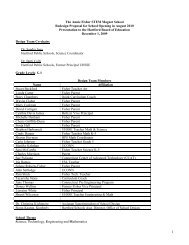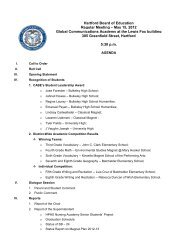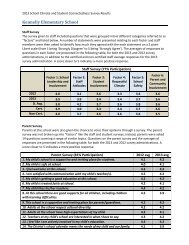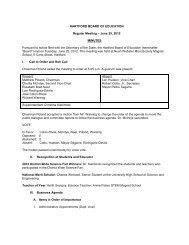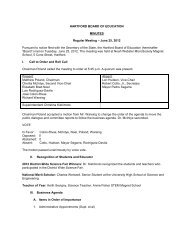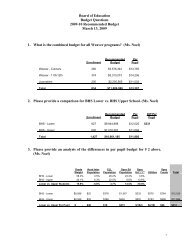Hartford Magnet Trinity College Academy - Hartford Public Schools
Hartford Magnet Trinity College Academy - Hartford Public Schools
Hartford Magnet Trinity College Academy - Hartford Public Schools
You also want an ePaper? Increase the reach of your titles
YUMPU automatically turns print PDFs into web optimized ePapers that Google loves.
HARTFORD PUBLIC SCHOOLS<br />
Phase II: School Design Specifications:<br />
<strong>Hartford</strong> <strong>Magnet</strong> <strong>Trinity</strong> <strong>College</strong> <strong>Academy</strong><br />
Overview of School Model<br />
Background<br />
<strong>Hartford</strong> <strong>Magnet</strong> Middle School opened in SY 2000-2001 as part of a larger urban magnet school vision called The<br />
Learning Corridor. As originally envisioned, the Learning Corridor included <strong>Trinity</strong> <strong>College</strong>, a Girls' and Boys' Club, the<br />
Institute for Living, the <strong>Hartford</strong> Children’s Medical Center, and three other magnet schools: Montessori <strong>Magnet</strong> School,<br />
Greater <strong>Hartford</strong> <strong>Academy</strong> of the Arts, and Greater <strong>Hartford</strong> <strong>Academy</strong> of Math and Science. The result of unprecedented<br />
determination and cooperation among its founding institutions, the Learning Corridor has transformed an educational<br />
vision into reality. HMMS has earned the distinction of being the highest performing school within the <strong>Hartford</strong> <strong>Public</strong><br />
<strong>Schools</strong> and has maintained autonomy status per the district’s OSI ranking score. <strong>Hartford</strong> <strong>Magnet</strong> Middle School in<br />
partnership with <strong>Trinity</strong> <strong>College</strong> seeks to carry on the Learning Corridor vision by expanding upon this success and<br />
creating <strong>Hartford</strong> <strong>Magnet</strong> <strong>Trinity</strong> <strong>College</strong> <strong>Academy</strong>, HMTCA. Together, <strong>Hartford</strong> <strong>Magnet</strong> Middle School and <strong>Trinity</strong><br />
<strong>College</strong> will extend the middle school design to include an Early <strong>College</strong> High School. The new grades 6-12 model will<br />
maintain its full interdistrict magnet school status from the Connecticut State Department of Education as a <strong>Hartford</strong> <strong>Public</strong><br />
<strong>Schools</strong> host magnet.<br />
Description of School Type, Accreditation & Affiliation Model<br />
<strong>Hartford</strong> <strong>Magnet</strong> <strong>Trinity</strong> <strong>College</strong> <strong>Academy</strong> will be a college preparatory model for 400 high school<br />
students, grades 9-12, who wish to pursue a course of study in science and the arts and spend their senior<br />
year on the <strong>Trinity</strong> <strong>College</strong> campus. The program will prepare students to be successful in college,<br />
setting them on a career pathway in the fields of science as well as the visual and performing arts.<br />
Proposed to open in August 2011 for Grade 9 students, the HMTCA will expand by one grade each year<br />
and reach capacity in 2014.<br />
The early college high school model integrates high school and college study in an articulated program.<br />
Five Core Principles provide the framework for planning and implementing early college schools:<br />
1. Early college schools are committed to serving students underrepresented in higher education.<br />
2. Early college schools are created and sustained by a local education agency, a higher education institution, and the<br />
community, all of whom are jointly accountable for student success.<br />
3. Early college schools and their higher education partners and community jointly develop an integrated academic<br />
program so all students earn one year of transferable college credit leading to college completion.<br />
4. Early college schools engage all students in a comprehensive support system that develops academic and social skills<br />
as well as the behaviors and conditions necessary for college completion.<br />
5. Early college schools and their higher education and community partners work with intermediaries to create<br />
conditions and advocate for supportive policies that advance the early college movement.<br />
The early college high school model provides students with a rigorous and supportive educational<br />
program that prepares students to experience success in college level courses before graduating from<br />
high school. Twelfth grade students meeting <strong>Trinity</strong> <strong>College</strong>’s criteria will have the opportunity to enroll<br />
in classes and receive dual credit. A Personalized Learning Plan (PLP) will be developed for all<br />
students that may include: college-level courses, Capstone Projects, professional internships, and studies<br />
abroad.<br />
The early college experience is a blend of high school and college in a rigorous and fully supportive<br />
program, compressing the time it takes to complete a high school diploma and the first year of college.<br />
The goal of the early college model is to reach students who typically fall through the cracks between<br />
America’s system of K-12 schools and its system of postsecondary education: low-income youth, first<br />
generation college-goers, English language learners, students of color and other young people<br />
underrepresented in higher education. This opportunity will allow students to save time and money and<br />
is a powerful motivator for students to work hard and meet serious intellectual challenges. The<br />
partnership will open doors for <strong>Hartford</strong>’s youth to attend a prestigious college and provide a pathway to<br />
<strong>Trinity</strong> <strong>College</strong> endowment scholarships.<br />
1



